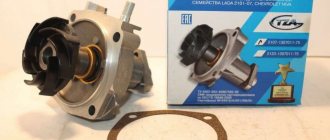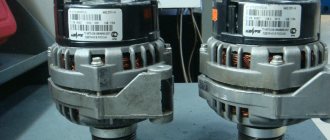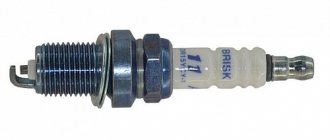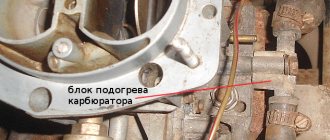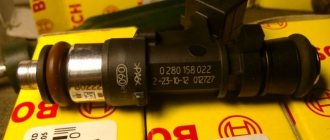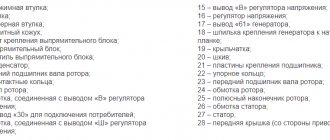Correct operation of a car engine is ensured by a combination of factors that must be constantly monitored, maintaining the necessary modes on the accompanying units.
One of the important indicators is the temperature of the coolant, which directly affects the speed of warming up the engine and the removal of excess heat from it. As in any other car, in the Chevrolet Niva, control of the parameter is assigned to the thermostat. This device, to a certain degree of temperature increase, maintains the circulation of coolant in a small circle, facilitating engine warm-up. When the antifreeze reaches 80–90 °C, the regulator automatically changes the exchange to a large circle, which includes a cooling radiator. The latter prevents the antifreeze from boiling and ensures that its temperature is maintained within the limits of the norms for correct heat removal from a running engine.
The thermostat itself on the Chevrolet Niva is mechanical. There are no third-party connections to it, except for the incoming and outgoing pipes of the cooling system.
How to check
There are two methods for checking the functionality of the regulator, depending on whether a thermostat is installed in the car or not. If the unit is already connected to the engine and while warming up, the upper pipe going to the radiator immediately becomes hot, the exchange device is not working properly. The same applies to the case when the engine is warmed up, but the “large circle” line remains cold.
Another test method is used when the thermostat is disconnected from the vehicle systems. If low pressure air is supplied through the inlet pipe, it should not come out of the top of the thermostat. Only at the bottom. A violation of the current current directly indicates a faulty unit.
How to replace the thermostat on a Chevrolet Niva (photo and video).
Hi all. The topic of this article is replacing the Chevrolet Niva thermostat. Traditionally for our site, the article is written in simple language and contains detailed photos and video instructions.
The Chevrolet Niva has an engine that is structurally similar to the VAZ 2107 engine, but due to the specifics of the car, the design of the cooling system is somewhat different.
If your car is cold in winter and the engine takes a very long time to warm up, or if the engine overheats, check the thermostat first. To do this, you need to perform several steps. First, we start the engine and monitor the temperature of the lower radiator pipe, which, under normal conditions, should be cold. If this is so, then there are no errors in the operation of the unit. The hose should begin to heat up at a temperature of 80-85 degrees. If the temperature of the pipe increases even when the engine is cold, then the thermostat needs to be replaced.
How is the thermostat replaced?
Before proceeding with the removal of the unit, you must wait until the engine has completely cooled down. There are two known methods for dismantling the thermostat. The first of them provides for partial drainage of the coolant, while the second does not. Below we will look at each of them separately.
Dismantling without draining the coolant.
To save time and remove the thermostat without draining the antifreeze, you must perform the following steps: 1. Prepare two wrenches and two bolts with nuts (or a wire as in the picture). 2. Using them, we clamp the antifreeze supply hoses. 3. Fix it in the desired position using nuts. If you did everything correctly, coolant will not be able to flow to the thermostat, and you can safely remove it. However, this method should only be used when you are completely confident in the reliability of the hoses. Otherwise, they will crack and leak.
Replacing the thermostat with coolant drain.
If you don’t want to take risks and hope that the hoses are working properly, you will have to drain all the antifreeze. We find the drain plug in the cylinder block and drain all the coolant. We remove the thermostat. We do this in the same way as described here.
Sequence of actions (briefly):
- We drain all the coolant by removing the plugs on the block.
- Using tools (screwdriver or wrench), loosen the fastenings of the pipes.
- Disconnect all pipes from the thermostat. This is the most difficult and tedious procedure, prepare a few swear words and everything will work out.
- Now we can safely dismantle the thermostat.
- Install everything in reverse order and fill in antifreeze
Which thermostat is best for Chevrolet Niva?
The free market, in addition to freedom of choice, unfortunately, is distinguished by the lack of control and the number of defects. Our practice has shown that WEEN thermostats last the longest and there are fewer defects among them. But it’s not a fact that you won’t run into a fake or that they will be on sale in your area. Therefore, even if you buy a new thermostat, be sure to “weld” it.
Today we discussed the process of replacing the Niva Chevrolet thermostat. We hope our article has become as useful as possible for you.
Best regards, administrator
Share
Symptoms of the problem and consequences
The main signs of a malfunctioning thermostat in a car are abnormal coolant temperatures when the engine is running. It may be too high when the radiator fan is working correctly and there is a sufficient amount of antifreeze itself, or too low when the engine is warm. A concomitant sign of the last symptom is a sharp jump in coolant temperature when the engine stops.
Valve malfunction can also be monitored by the behavior of the temperature sensor when the machine is moving. When the speed increases, it shows values below normal, and when it decreases, on the contrary, higher.
A thermostat failure on a Niva reduces the service life of the motor and its final operating life, accelerating the wear of mechanisms due to constant overheating.
Unit design and reasons for failure
The Niva-Chevrolet thermostat is unified with all modern LADA car models. The basis of its operation is a mechanical system with a heat-sensitive element. While the latter is not sufficiently heated from the antifreeze, the flow of the coolant is limited to a “small circle” from the engine with its simultaneous return to it. As soon as the wax, which acts as a defining element, warms up in the thermostat, the internal piston will block the pipe coming directly from the engine, and the mechanism itself will open the flow of coolant from the radiator.
There are two main reasons for the failure of this system. The first is the ingress of dirt particles into the mechanism itself and the second is wear and tear of the wax valve over time. Regardless of what happened, it is recommended not to repair the unit, but to completely replace it.
With drain
If you do not want to test the hoses for strength, then you will have to drain all the antifreeze that is located above the thermostat. To do this, you need to use the drain plug in the cylinder block. You must act carefully so that liquid does not get on the generator. After draining the liquid, we clamp the hose and proceed to dismantling the thermostat. Next you need to follow the sequence:
- Using a Phillips screwdriver, loosen the clamps. You need to start with the conductive one and only then move on to the outlet hose.
- We perform the same action with the heater hose going to the cylinder block.
- Carefully remove all hoses so that coolant does not get on the generator.
- We remove the old unit and install a new one.
Installation of the new element is carried out in the reverse order. If the old thermostat is non-separable (this is the classic version in most cases), and the valve on it does not work, you can safely throw it away.
TOP thermostat models
The list of thermostat manufacturers for Niva is quite large. The average price level for a device is around 500 rubles. Based on reviews, the most popular models for 2020/early 2021 will be:
| Manufacturer | vendor code | Price |
| Lugar | LT 0123 | 540 |
| Lugar | LT 0124 | 660 |
| LADA | 21230-1306010-83 | 680 |
| Belmag | BM.0240 | 390 |
| Pilenga | Tt-P 4002 | 350 |
All thermostats from the listed manufacturers are of the required level of quality and are recommended for purchase by many automotive professionals. It is difficult to determine which is better from the list. All of them interact well with the standard Chevy Niva engine cooling system, passing related tests for trouble-free operation.
Manufacturers and types
Standard sizes of thermostats, which by their design are suitable for installation in the engine of a Chevrolet Niva car, are produced by a number of global companies. The table below presents a list of products.
| Model | Product serial number | Opening temperature |
| Thomson | 21230-1306010-05-0 | 80° |
| Zommer | 2123-1306010 | 80° |
| Metal Inkar | 2123-1306010-01 | 80° |
| Pramo | 2123-1306010-02 | 80° |
| WEEL | 182-0114 | 80° |
| Luzar | LT0123 | 80° |
| Herzog | HL36010 | 80° |
| Vkt | VT29003 | 80° |
| Fenox | TS009E7 | 80° |
| Finord | 21231306010 | 80° |
| Baker | 21231306010 | 80° |
| Finwhale | FinwhaleT123 | 80° |
| Gallant | GLTH14 | 80° |
| Hofer | HF 445 730 | 80° |
There is an opinion among car owners that the highest quality, reliable and durable thermostats are products produced by Russian factories. There are currently three such enterprises:
Among foreign models, car owners have good reviews of the Metal Inkar model from the Polish manufacturer.
These products work great in the Chevrolet Niva cooling system, the engine warms up quickly, there are no complaints.
The only negative is that the body is made in two versions - plastic and brass. The second option is not very popular among drivers, although it also works well in a circuit.
Zommer, Luzar, WEEL thermostats should only be selected from approved manufacturers. There are a lot of fakes on the market and on the Internet. Retailers seek to sell their dubious products under the guise of original ones to newcomers in the automotive business. To avoid getting burned, when purchasing, you must require licenses, certificates and supporting documents from sellers.
Replacement
Before removing the thermostat, it is imperative to lower the antifreeze level. The disassembly itself is carried out on a cold engine to avoid burns from the hot coolant.
The regulator is attached to the cooling system with sealing clamps on each of the five supply pipes. The unit is dismantled by unscrewing them.
After installing the new thermostat, the fasteners return to their original place. Before replenishing the antifreeze level, disconnect the cooling system pipe leading to the engine throttle assembly. The latter is done to bleed off excess air when filling the liquid.
Modification of the thermostat
Some car enthusiasts modify the regulator, adding to it the ability to manually control the stroke of the piston, which controls the shutoff of the small circle pipe. For this purpose, a hole is made at the bottom of the thermostat housing and the thread is cut with a tap. A bolt is screwed in there, which subsequently, resting against the piston of the mechanism, will limit its movement when heated.
The system is adjusted with the engine in operating mode. The bolt is screwed in until the engine temperature on the dashboard reaches 90 °C.
If the walls of the thermostat are too thin, as for example with Lugar products, use an M5 threaded rivet instead of threading. The stroke of the bolt is limited by lateral rolling not only from above, but also inside the control device, so that it precisely hits the piston of the latter.
